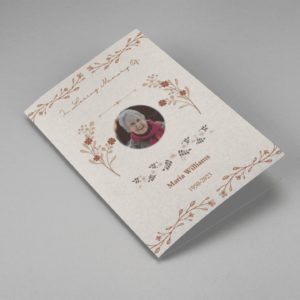
Losing a loved one is a profound experience that leaves an indelible mark on our hearts. One way to honor and remember those we have lost is through Memorial Remembrance Cards. These cards serve as a lasting tribute, offering comfort to those who mourn and ensuring that the memory of the deceased remains alive. In this guide, we will explore everything you need to know about Memorial Remembrance Cards, including their significance, design options, and how to create the perfect card for your loved one.
What Are Memorial Remembrance Cards?
Memorial Remembrance Cards are small, personalized cards distributed during or after a funeral or memorial service. They typically feature a photo of the deceased, their name, birth and death dates, and a meaningful message, poem, or prayer. These cards are often kept by family members and friends as a keepsake, serving as a tangible reminder of the person who has passed away.
The Significance of Memorial Remembrance Cards
The act of creating and distributing Memorial Remembrance Cards is a tradition that dates back centuries. These cards play a significant role in the grieving process by:
- Providing Comfort: They offer words of solace and hope to those who are mourning.
- Preserving Memories: By including a photo and personal details, these cards help keep the memory of the deceased alive.
- Creating a Connection: Memorial Remembrance Cards allow mourners to share their grief and remember the deceased collectively.
Designing the Perfect Memorial Remembrance Card
Creating a Memorial Remembrance Card is a deeply personal process. The design and content should reflect the personality and life of the deceased while providing comfort to those who receive it. Here are some key elements to consider when designing a Memorial Remembrance Card:
1. Choosing the Right Photo
The photo on a Memorial Remembrance Card is one of the most important elements. It should capture the essence of the person who has passed away. Consider using a photo that:
- Shows the Deceased at Their Best: Choose a picture where the person is smiling or in a happy moment.
- Is of High Quality: A clear, high-resolution image will look best on the card.
- Holds Special Meaning: The photo could be from a significant event or time in the person’s life.
2. Selecting Meaningful Text
The text on the card should convey a message of love, remembrance, and comfort. Some common text options include:
- The Deceased’s Name and Dates: Include the full name, date of birth, and date of death.
- A Short Biography: A brief summary of the person’s life, highlighting their achievements and the roles they played in the lives of others.
- Poems or Prayers: A favorite poem, a passage from scripture, or a comforting prayer can add a spiritual element to the card.
- Personal Messages: A heartfelt message from the family, expressing their love and loss.
3. Choosing a Design Theme
The design of the Memorial Remembrance Card should reflect the personality of the deceased and the tone of the memorial service. Consider these themes:
- Traditional: Simple designs with classic fonts and borders, often in muted colors like black, white, or navy blue.
- Religious: Cards featuring religious symbols, such as crosses or doves, and scripture passages.
- Nature-Inspired: Designs with images of nature, like flowers, trees, or landscapes, symbolizing peace and tranquility.
- Modern: Sleek, contemporary designs with bold fonts and vibrant colors, ideal for someone with a modern, vibrant personality.
4. Selecting the Right Paper and Printing Options
The quality of the paper and printing can greatly impact the overall look and feel of the Memorial Remembrance Card. Consider the following:
- Paper Quality: Choose a high-quality cardstock that feels substantial and durable.
- Finish: A glossy finish can make the photos pop, while a matte finish offers a more subdued, elegant look.
- Size: Common sizes include 4” x 6” or 5” x 7”, but you can choose a size that best fits your design.
- Quantity: Make sure to order enough cards for all attendees, with some extras for those who couldn’t attend the service.
Personalizing Your Memorial Remembrance Cards
Personalization is key when it comes to Memorial Remembrance Cards. Here are some ideas to make the cards unique:
1. Adding a Personal Touch
Consider including personal touches that reflect the deceased’s personality, such as:
- Favorite Quotes: Include a quote that was meaningful to the deceased.
- Hobbies or Interests: Incorporate symbols or images related to their hobbies, such as musical notes for a musician or a paintbrush for an artist.
- Family Photos: In addition to a single portrait, you can include a collage of family photos.
2. Customizing the Layout
The layout of the card can be customized to fit your preferences. Consider these options:
- Single-Sided or Double-Sided: Double-sided cards offer more space for text and images.
- Folded Cards: A folded card can create a booklet-like effect, offering even more space for personalization.
- Bookmark Style: Some choose to create Memorial Remembrance Cards in a bookmark style, which can be used in the recipient’s favorite book.
3. Choosing Colors and Fonts
The colors and fonts you choose should complement the overall design of the card. Consider the following:
- Color Scheme: Choose colors that were meaningful to the deceased or that match the tone of the service.
- Font Style: Select a font that is easy to read and reflects the mood you want to convey—whether that’s traditional, modern, or whimsical.
Ideas for What to Write on a Memorial Remembrance Card
Finding the right words can be challenging, especially during a time of grief. Here are some ideas to help you craft the perfect message:
1. Religious Verses and Prayers
For those who were religious, including a verse from the Bible, Quran, or another religious text can be comforting. Examples include:
- Psalm 23: “The Lord is my shepherd; I shall not want…”
- John 14:27: “Peace I leave with you; my peace I give you…”
- Islamic Prayer: “Inna Lillahi wa inna ilayhi raji’un” (“Verily we belong to God, and verily to Him do we return”).
2. Inspirational Quotes
Quotes from famous authors, poets, or philosophers can provide comfort and perspective. Some examples include:
- Helen Keller: “What we have once enjoyed we can never lose; all that we love deeply becomes a part of us.”
- Mahatma Gandhi: “There are no goodbyes for us. Wherever you are, you will always be in my heart.”
- Ralph Waldo Emerson: “It is not the length of life, but the depth of life.”
3. Personal Messages
A personal message from the family can add a warm, intimate touch to the card. Consider writing:
- Expressions of Gratitude: “Thank you for sharing in our sorrow and helping us celebrate [Name]’s life.”
- Memories: “We will always remember [Name] for their kindness and love.”
- Well Wishes: “May the memories of [Name] bring you peace and comfort.”
Distributing Memorial Remembrance Cards
Once you have created your Memorial Remembrance Cards, consider how you will distribute them:
1. During the Funeral or Memorial Service
Cards can be placed on a table at the entrance of the service or handed out to attendees as they arrive. This allows everyone present to take home a keepsake.
2. Mailing to Those Who Couldn’t Attend
For family and friends who couldn’t attend the service, mailing a Memorial Remembrance Card can be a thoughtful gesture. Include a note expressing your appreciation for their support.
3. Creating Digital Memorial Cards
In today’s digital age, some families choose to create digital versions of their Memorial Remembrance Cards. These can be shared via email or social media, ensuring that everyone, regardless of location, can receive a keepsake.
Funeral Remembrance Cards
-
Searching for a Oak Leaf With Gold Oval Frame Half Page Funeral Program that is easy to print and amass and has a cutting-edge look? The Oak Leaf With Gold Oval Frame Half Page Funeral Program is the Perfect decision because it measures 8.5”x 5.5”.
- No Limitation on Content, Edit anything
- Edit anytime – unlimited revisions even after purchased
- Get a printable PDF downloaded to get it printed on your own.
-
Searching for a Brown and White Classic Funeral Program Half Page Program that is easy to print and amass and has a cutting-edge look? The Brown and White Classic Funeral Program Half Page Program is the Perfect decision because it measures 8.5”x 5.5”.
- No Limitation on Content, Edit anything
- Edit anytime – unlimited revisions even after purchased
- Get a printable PDF downloaded to get it printed on your own.
-
Searching for a Purple Elegant Watercolor Half Page Funeral Program Template that is easy to print and amass and has a cutting-edge look? The Purple Elegant Watercolor Half Page Funeral Program Template is the Perfect decision because it measures 8.5”x 5.5”.
- No Limitation on Content, Edit anything
- Edit anytime – unlimited revisions even after purchased
- Get a printable PDF downloaded to get it printed on your own.
-
Searching for a Cream and Green Photo Obituary Half Page Program that is easy to print and amass and has a cutting-edge look? The Cream and Green Photo Obituary Half Page Program is the Perfect decision because it measures 8.5”x 5.5”.
- No Limitation on Content, Edit anything
- Edit anytime – unlimited revisions even after purchased
- Get a printable PDF downloaded to get it printed on your own.
-
Searching for a Cream Simple Elegant Photo Church Half Page Program that is easy to print and amass and has a cutting-edge look? The Cream Simple Elegant Photo Church Half Page Program is the Perfect decision because it measures 8.5”x 5.5”.
- No Limitation on Content, Edit anything
- Edit anytime – unlimited revisions even after purchased
- Get a printable PDF downloaded to get it printed on your own.
-
Searching for a Samovar Silver Half Page Funeral Program Template that is easy to print and amass and has a cutting-edge look? The Samovar Silver Half Page Funeral Program Template is the Perfect decision because it measures 8.5”x 5.5”.
- No Limitation on Content, Edit anything
- Edit anytime – unlimited revisions even after purchased
- Get a printable PDF downloaded to get it printed on your own.
-
Searching for an Elegant Beige Half Page Funeral Program Template that is easy to print and amass and has a cutting-edge look? The Elegant Beige Half-Page Funeral Program Template is the Perfect decision because it measures 8.5”x 5.5”.
- No Limitation on Content, Edit anything
- Edit anytime – unlimited revisions even after purchased
- Get a printable PDF downloaded to get it printed on your own.
-
Searching for a White Floral Pro Half Page Funeral Program Template that is easy to print and amass and has a cutting-edge look? White Floral Pro Half Page Funeral Program Template is the Perfect decision because it measures 8.5”x 5.5”.
- No Limitation on Content, Edit anything
- Edit anytime – unlimited revisions even after purchased
- Get a printable PDF downloaded to get it printed on your own.
-
Searching for a Grey and Burgundy Elegant Half Page Funeral Program Template that is easy to print and amass and has a cutting-edge look? Grey and Burgundy Elegant Half Page Funeral Program Template is the Perfect decision because it measures 8.5”x 5.5”.
- No Limitation on Content, Edit anything
- Edit anytime – unlimited revisions even after purchased
- Get a printable PDF downloaded to get it printed on your own.
-
Searching for a Soft Green and Grey Minimalist Floral Half Page Funeral Program Template that is easy to print and amass and has a cutting-edge look? Soft Green and Grey Minimalist Floral Half Page Funeral Program Template is the Perfect decision because it measures 8.5”x 5.5”.
- No Limitation on Content, Edit anything
- Edit anytime – unlimited revisions even after purchased
- Get a printable PDF downloaded to get it printed on your own.
-
Searching for a Gray Elegant Oval Frame Half Page Funeral Program Template that is easy to print and amass and has a cutting-edge look? Gray Elegant Oval Frame Half Page Funeral Program Template is the Perfect decision because it measures 8.5”x 5.5”.
- No Limitation on Content, Edit anything
- Edit anytime – unlimited revisions even after purchased
- Get a printable PDF downloaded to get it printed on your own.
-
Searching for a Blue Organic Minimal Half Page Funeral Program Template that is easy to print and amass and has a cutting-edge look? Blue Organic Minimal Half Page Funeral Program Template is the Perfect decision because it measures 8.5”x 5.5”.
- No Limitation on Content, Edit anything
- Edit anytime – unlimited revisions even after purchased
- Get a printable PDF downloaded to get it printed on your own.
-
Searching for a Pink and Orange Watercolour Half Page Funeral Program Template that is easy to print and amass and has a cutting-edge look? Pink and Orange Watercolour Half Page Funeral Program Template is the Perfect decision because it measures 8.5”x 5.5”.
- No Limitation on Content, Edit anything
- Edit anytime – unlimited revisions even after purchased
- Get a printable PDF downloaded to get it printed on your own.
-
Searching for a Pink Floral Paper Half Page Funeral Program Template that is easy to print and amass and has a cutting-edge look? Pink Floral Paper Half Page Funeral Program Template is the Perfect decision because it measures 8.5”x 5.5”.
- No Limitation on Content, Edit anything
- Edit anytime – unlimited revisions even after purchased
- Get a printable PDF downloaded to get it printed on your own.
Funeral Programs : Helping Videos
Frequently Asked Question On Memorial Remembrance Cards for Loved Ones
What is the purpose of a Memorial Remembrance Card?
Memorial Remembrance Cards are small, personalized keepsakes that honor the memory of a deceased loved one. They serve as a lasting tribute and provide comfort to family and friends by preserving the memory of the deceased.
What should be included on a Memorial Remembrance Card?
A typical Memorial Remembrance Card includes the deceased’s name, birth and death dates, a photo, a short biography or personal message, and sometimes a poem, prayer, or inspirational quote. The design can also include symbols, colors, or images that were meaningful to the deceased.
What are some design options for Memorial Remembrance Cards?
Design options vary widely and can include traditional, religious, nature-inspired, or modern themes. You can choose from different layouts, such as single-sided, double-sided, or folded cards, and customize colors, fonts, and other design elements to suit your preferences.
Can I create digital Memorial Remembrance Cards?
Yes, digital Memorial Remembrance Cards are an option for those who prefer a more modern approach. These can be shared electronically, allowing people from different locations to receive a remembrance even if they cannot attend the service.














